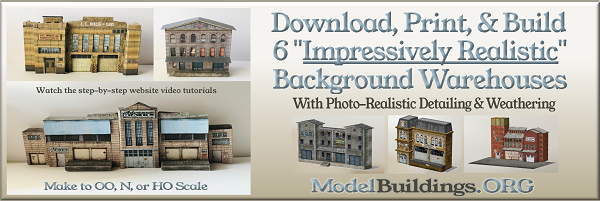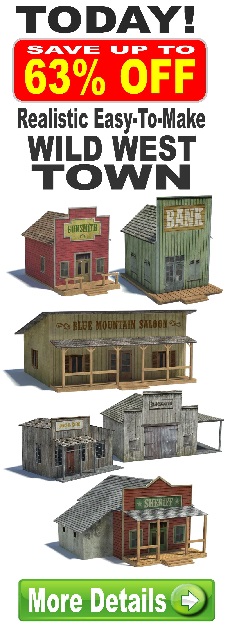Everything on model trains, model railroads, model railways, locomotives, model train layouts, scenery, wiring, DCC and more. Enjoy the world's best hobby... model railroading!
Which Model Train Scale To Use?
Jon asks readers:
“I am planning a layout and I am completely new to model railways. I have approx .5 mtrs long x 4 mtrs wide space, I am not too sure which scale to use. I a planning a Didcot to Oxford to Swindon/Reading layout, with a goods yard at Didcot.”
6 Responses to Which Model Train Scale To Use?
Leave a Reply
















There are fourl major factors that determine what scale to work with.
The factors are: 1.) Layout location, 2.) Scale interest, 3.) Cost, and 4.) Family members.
1.) Layout location:
Figure out where and how large of an area that you can dedicate to your layout. A basement or attic area can generally provide a larger area to spread out your layout in, while a spare bed room or a small den area will be more confining.
2.) Scale that you find interesting:
A.) If you are not too mechanically inclined but have a good sized back yard that you can use, “G” scale can provide a satisfying feeling and impression. This scale is large and fairly easy to handle but there is not much in the way of ready-make structures, so you would be making a lot of material to populate your layout. So if you are a creative person who is good with your hands and hand tools, this is a good scale to work with.
B.) If you are somewhat of a collector at heart but have limited grasping abilities due to arthritis, and your vision is not so great but you do have a large area that you can dedicate for a layout, then I suggest “O” scale. Best known brands are Lionel and American Flyer but there are other good brands as well. This scale is sometimes referred to as “Tin-Plate” models and is a very popular scale for collectors who specialize in Pre- and Post-World War II items.
C.) Then there is “HO” in U.S. America or “OO” in the British Commonwealth. This scale is about half that of “O” scale and almost the De-facto standard for American model train enthusiast. A fairly modest layout can be created on a 4 foot by 8 foot board. This is also one of the most common scales used by model railroad clubs when they create a club layout. This scale has about the most material for creating a layout with. There are many types of rolling stock, structures, (like buildings and stations structures), tracks, track switches and turnouts, car and truck models and even miniature animals and people to populate your layout with. This is a very popular scale to work with.
D.) Next in line is “N” scale. Again this scale is about half the size of “HO” or “OO” scale. This scale is a up-coming popular scale because it takes up just about half the area that “HO” takes up, so a person can create a large layout on a 4 foot by 8 foot board, or a nice layout in the space of 36 inch by 80 inch area, (about the area of a standard American door). Draw-backs to this and smaller scales is that details are harder to see and the rolling stock and structures are harder to handle for people who have limited grasping abilities. This scale is not bad for creating an around the room, shelf layout with. This is another scale that model railroad clubs work in. Some modelers have created portable layouts in moderate sized suitcases, using this scale.
E.) “Z” scale, the smallest scale that I would recommend. This scale is just about a quarter to a third the size of “HO”. Popular for those who have good dexterity, good eye sight and very little room for a layout. There is not much in the way of pre-made structures for this scale, so you would have to make a lot of things from detailed drawings and plans for your layout. This scale is small enough that modelers have created complete portable layouts in briefcases with it.
These are common scales but there are those that are between these, that modelers also work in. There are a wide selection to chose from. It is very wise to to do research into the various scales that you find interesting, well before you make a finale decide on which one to create your model railroad empire in.
3.) Cost of materials:
This is is a major factor to consider. Based on “HO” scale as a most common scale to work in, cost of materials, rolling stock and structures can be thought of as a pricing standard. Cost of materials for other scales larger than or smaller than “HO”, will and do cost more due to amount of materials used, type of materials or amount of detailing involved in the production of the scale. So larger scale items cost more due to the amount and types of material used, while smaller scales cost more due to materials, details and methods used in production of the smaller scales.
4) Family:
This is something that a lot of people miss on. You need to account for your spouse, would they be interested in sharing in your interest of model railroads? Your children, do you wish to involve them in your interest when they are old enough to show interest? What about older members, do they share your interest? And lastly, what about friends, possible club members and visitors? Do you wish to include them in operation of your layout? Then for each, you have to consider their abilities and possible skill level. How well are they able to see, or hold onto things that may be large or small, or understand simple directions? Older people can see and handle large things pretty well and can understand directions without much trouble while such may not be the case for a small child, or a person with disabilities.
So these are the things to consider when you ask yourself; “What scale should I model in?”
You have chosen a massive amount of railway to model, 4 track main line with a huge triangular junction enclosing a loco shed and shunting yard complex at Didcot so realistically you are looking at N gauge to get this in to 18 feet by 13. Almost all the GWR locomotive classes would have used this line as well as at least 2 Southern locos and trains per day on Poole York trains.
If you want to use a larger scale just a small part based anywhere between Reading west junction and Didcot would be good or Didcot and Oxford if you did not want King class which was only allowed light engine en route to Swindon Works.
I planned a layout based on Moreton Cutting yard, the marshalling yard for East bound freights just East of Didcot on a 4 track section of line at one time but it was too ambitious.
Personally I think your ambitions need scaling down to either model asmall station accurately or invent a completely fictional station, though hopefully a bit more believable than Pendon’s Vale of the white horse layout with its huge tunnel, something the GWR did not have in the Reading Didcot Oxford area.
Jon, from what you say about the space available, I would say OO (HO). You can get quite a lot of features in that space. If you went for O gauge – If you mean you can have a board all round the walls of a room 5m long by 4m, you could have an oval with a station on one side and and a goods yard on the other. The board should be about 60 to 80 cm wide. But the minimum turn radius is quite large, depending on what sort of locos you want to run. I have a British steam O gauge model and 4-6-0s and 4-4-2s won’t go round less than about 1 metre radius bends, even with some modification. Whereas Bogie locos and rolling stock and some 0-6-0s will go round sharper bends.
It all depends on what country and style of railway you want. If possible visit quite a few model railway exhibitions and see what takes your fancy. In the UK, ukmodelshops.co.uk has an events calendar and lots of info on suppliers. But OO is the least expensive, most easily obtained, reasonably easy to work with and most variety if you have your sort of space. Note that dog bone layouts or half the layout hidden in a tunnel, are more interesting than Ovals! Good luck!
Whatever you do don’t burden yourself with a massive dream which can turn into a nightmare because of size, complexity, time available for the hobby, your wife’s thoughts on the matter (happy wife, happy life). My Norwest Bend railway is still in its paper stage. I have 5 x 6 metres to play with; it’s all mine and the finances are in place to built it. BUT – I want 9 stations plus a heap of hidden staging to somehow cram in. One of those is the river port of Morgan so I’ll have to factor in mooring for the paddle steamers.
I am an experienced model railroader and I can tell you I’m baffled so I wonder about a neophyte taking on Didcot. I’m not saying don’t do it, just be aware of the space and time limitations
Good luck.
This is a very ambitious project for one person to even consider. Have a look at the layout of Bath Green Park that is on the West Somerset Railway at Bishops Lydyeard and see what that group of medellers has done. It is huge and covers less distance than your plan proposes. I think David Stokes advice is very good and that you may need to reconsider your plan and perhaps model just Didcot itself, which although much smaller, would be a huge one-man project in the space you have available.
Good luck.
You should use 00